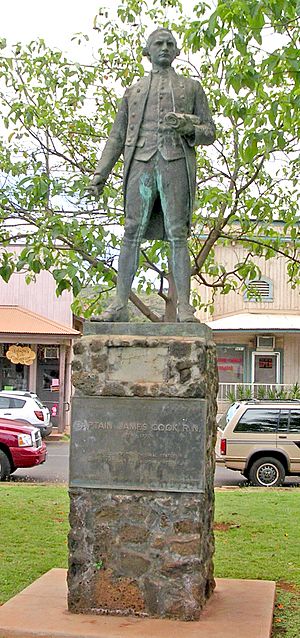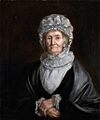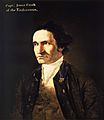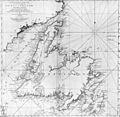James Cook facts for kids
Quick facts for kids
Captain James Cook
|
|
|---|---|
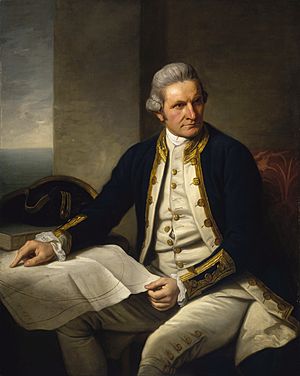
|
|
| Born | 7 November [O.S. 27 October] 1728 Marton, Yorkshire, England
|
| Died | 14 February 1779 (aged 50) |
| Nationality | British |
| Education | Postgate School, Great Ayton |
| Occupation | Explorer, navigator, cartographer |
| Title | Captain |
| Spouse(s) | Elizabeth Batts |
| Children | 6 |
| Parent(s) | James Cook Grace Pace |
| Signature | |
 |
|
Captain James Cook (27 October 1728 – 14 February 1779) was a famous English explorer, navigator, and mapmaker. He made three big trips across the Pacific Ocean. On these journeys, he mapped many new areas. He was the first to record several islands and coastlines on European maps.
Cook is best known for helping the British find the east coast of Australia. He also found the Hawaiian Islands and was the first to map Newfoundland and New Zealand. During his life, he sailed around the world twice. He even crossed the Antarctic Circle and found new lands in North America and the South Pacific. Cook spent a lot of time doing science experiments and mapping new places. He also wrote many books about his discoveries.
Contents
Early Life and First Jobs
James Cook was born on 7 November 1728 in a village called Marton in Yorkshire, England. He was the second of eight children. His father was a farm worker from Scotland, and his mother was from a nearby town.
In 1736, his family moved to a farm in Great Ayton. James went to the local school there. His father's boss, Thomas Skottowe, paid for his schooling. After five years, in 1741, James started working with his father, who had become a farm manager.
Starting a Sea Career
In 1745, when James was 16, he moved about 20 miles (32 km) to the fishing village of Staithes. He worked as a shop assistant for a grocer named William Sanderson. Some historians think this is where Cook first felt drawn to the sea. He would look out of the shop window at the ocean.
After 18 months, Cook realized he didn't like shop work. He went to the nearby port town of Whitby. There, he met John and Henry Walker, who were friends of Sanderson. The Walkers were important ship-owners in the coal trade. Their house is now the Captain Cook Memorial Museum. Cook became an apprentice on their merchant ships. These ships carried coal along the English coast.
His first job was on a coal ship called the Freelove. He spent several years on this and other ships, sailing between the Tyne and London. As part of his training, Cook studied important skills like algebra, geometry, trigonometry, navigation, and astronomy. These were all skills he would need to command his own ship one day.
After his three-year apprenticeship, Cook worked on trading ships in the Baltic Sea. He passed his exams in 1752 and quickly moved up in the merchant navy. In 1755, he joined the Royal Navy. Britain was getting ready for a big war, which later became the Seven Years' War.
While serving in the Royal Navy, Cook showed a great talent for surveying and cartography (making maps). He was responsible for mapping a large part of the entrance to the Saint Lawrence River. His mapping skills were very useful in the 1760s. He mapped the rough coast of Newfoundland. This work brought him to the attention of the Royal Society, a famous scientific group.
Voyages of Exploration
On 25 May 1768, the British Navy asked Cook to lead a scientific trip to the Pacific Ocean. Cook, who was 39, was promoted to lieutenant to give him enough authority for the command. The Royal Society also agreed to pay him extra money for his work.
The main goals for these missions were:
- to find a large southern continent, which people called terra australis incognita (unknown southern land).
- to make astronomical measurements of the planet Venus.
- to map new lands.
- to claim new lands for the British King George III.
- to look for good places for new military bases.
- to find new sea routes between the Pacific and Atlantic oceans.
First Voyage (1768–1771)
In 1766, the Royal Society hired Cook to travel to the Pacific Ocean. His mission was to watch and record the planet Venus as it passed across the Sun. He left in 1768 and arrived in Tahiti on April 13, 1769. There, he built a small fort and observatory to watch Venus. However, because their scientific tools were not very precise, they couldn't measure it perfectly.
After that, he explored the South Pacific. He was looking for the mythical continent of Terra Australis. A Tahitian man named Tupaia, who knew a lot about Pacific geography, helped him. The Royal Society believed Terra Australis had to exist, even though Cook had doubts.
He also reached New Zealand. Before him, only one other European, Abel Tasman in 1642, had visited it. Cook mapped its entire coastline. He discovered Cook Strait, which separates the North Island from the South Island. Next, he sailed to Australia and discovered its east coast.
Cook's first landing spot in Australia was at Kurnell on Botany Bay. This place was originally planned to be the first British colony in Australia. But when Captain Arthur Phillip arrived in 1788, he found Botany Bay unsuitable. He then sailed north a short distance to Port Jackson, where he established Sydney.
Botany Bay was important because it was one of the first places where Europeans met Aborigines. It was also where Europeans first saw many unique Australian plants and animals. The name Botany Bay was chosen because of all the different plants found there.
Cook also discovered the Great Barrier Reef. His ship, the Endeavour, hit the reef on June 11th 1770. The ship was badly damaged, and his journey was delayed for two months for repairs. He then sailed through Torres Strait, between Australia and New Guinea. He was only the second European to do this. His ship on this voyage, HM Bark Endeavour, later inspired the name for the Space Shuttle Endeavour.
By this point, Cook had not lost any men to scurvy, a disease caused by lack of vitamin C. This was an amazing achievement for the 18th century. He made his men eat foods like citrus fruits and sauerkraut. Unfortunately, he sailed to Batavia (now Jakarta), the capital of the Dutch East Indies, for more repairs. Batavia was known for outbreaks of malaria. Many of Cook's crew got sick and died from malaria before they returned home in 1771. When Cook's journals were published, he became a hero among scientists.
Second Voyage (1772–1775)
The Royal Society again asked Cook to search for the mythical Terra Australis. Even though Cook's first voyage suggested it didn't exist, some people still believed it did. On this voyage, Cook commanded HMS Resolution. Another captain, Tobias Furneaux, commanded HMS Adventure.
Cook sailed around the world very far south. On January 17, 1773, he became the first European to cross the Antarctic Circle. In the thick Antarctic fog, Cook and Furneaux got separated. Furneaux sailed to New Zealand and eventually returned to Britain. Cook continued exploring the Antarctic.
On his way back, he landed at the Friendly Islands and Easter Island. He returned home having proven that the huge southern continent, Terra Australis, did not exist. Another success of this voyage was testing John Harrison's special clocks. These clocks finally allowed sailors to accurately measure their longitude (east-west position).
After this voyage, Cook was given an honorary retirement from the Royal Navy. But he loved the sea too much to stay away. So, a third voyage was planned to find the Northwest Passage. This was a sea route through North America that would connect the Pacific and Atlantic oceans. Cook would travel east from the Pacific, while another ship would try to travel west.
Third Voyage (1776–1779)
On his last voyage, Cook again commanded HMS Resolution. Captain Charles Clerke commanded HMS Discovery. In 1778, Cook traveled north and became the first European to visit the Hawaiian Islands. He named them the "Sandwich Islands" after a British lord.
From Hawaii, he sailed east to explore the west coast of North America. He landed at Nootka Sound on Vancouver Island. He explored and mapped the coast from California all the way to the Bering Strait. Along the way, he discovered what is now known as Cook Inlet in Alaska.
Personal Life
Cook married Elizabeth Batts on 21 December 1762. Elizabeth was the daughter of Samuel Batts, who ran the Bell Inn in Wapping. They had six children: James, Nathaniel, Elizabeth, Joseph, George, and Hugh. Sadly, all of their children died young and did not have children of their own.
When Cook was not at sea, he lived in the East End of London. He attended St Paul's Church, Shadwell, where his son James was baptized.
Death
Cook tried to continue exploring the Northern Pacific. But shortly after leaving Hawaii Island, the Resolution's front mast broke. So, the ships had to return to Kealakekua Bay for repairs. During this time, problems grew between the Europeans and the Hawaiians.
One day, a group of Hawaiians took one of Cook's small boats. Cook became very frustrated. He decided to try and take the Hawaiian King Kalaniʻōpuʻu as a hostage.
The next day, 14 February 1779, Cook went into the village to get the King. Cook took the King's hand and led him away. But the King soon realized Cook was not a friend. As Cook turned his back to help launch the boats, he was attacked by villagers. This led to his death. The Hawaiians carried his body away. Four British marines were also killed, and two others were hurt in the fight.
Cook's Legacy
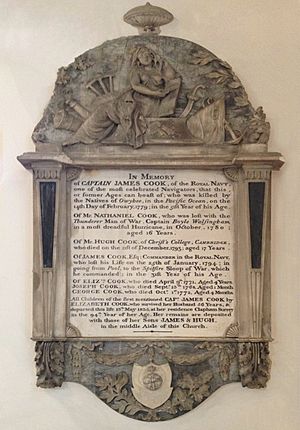
The Australian Museum received its Cook Collection in 1894. This collection included 115 items gathered during Cook's three voyages across the Pacific Ocean (1768–1780). It also had documents and other things related to these trips.
Cook's 12 years of sailing around the Pacific Ocean greatly increased Europe's knowledge of the area. Several islands, like the Sandwich Islands (Hawaii), were found by Europeans for the first time. His more accurate maps of large parts of the Pacific were a huge achievement.
Cook brought several scientists on his voyages. They made important observations and discoveries. Two botanists, Joseph Banks and Daniel Solander, were on the first voyage. They collected over 3,000 plant species. Banks later strongly supported British settlement in Australia.
Artists also sailed with Cook. Sydney Parkinson drew many of the plants found by the botanists, completing 264 drawings. These drawings were very valuable to British botanists. Cook's second trip included William Hodges, who created famous landscape paintings of Tahiti, Easter Island, and other places.
Cook's contributions to knowledge were recognized worldwide during his lifetime. In 1779, while the American colonies were fighting Britain for their independence, Benjamin Franklin wrote to American warship captains. He told them that if they met Cook's ship, they should "not consider her an enemy." He asked them to treat Cook and his crew with kindness, "as common friends to mankind." Franklin did not know that Cook had died a month before he wrote this special "passport."
Cook's voyages also involved an unusual first. The first animal to sail around the world twice was Cook's goat! When they returned to England, she lived out her life on Cook's farm. Cook's journal recorded the goat's death on 28 March 1772.
A US coin, the 1928 Hawaiian half dollar, shows Cook's image. It was made for the 150th anniversary of his discovery of the islands. Only 10,008 were made, making this coin rare and expensive.
The place where Cook was killed in Hawaii, Kealakekua Bay, was marked in 1874 by a white monument. This small piece of land, even though it's in Hawaii, was given to the United Kingdom. A nearby town is named Captain Cook, Hawaii. Several Hawaiian businesses also use his name.
The first university in North Queensland, Australia, was named after him. James Cook University opened in Townsville in 1970. Many other places and landmarks are named after Cook, showing how important his work was. These include the Cook Islands, the Cook Strait, Cook Inlet, and even the Cook crater on the Moon. Aoraki/Mount Cook, the highest mountain in New Zealand, is named for him.
Another Mount Cook is on the border between Alaska (USA) and the Yukon Territory (Canada). A life-size statue of Cook stands on a column in a park in the center of Sydney, Australia.
Interesting Facts About James Cook
- As a child, Cook liked to be alone and would climb a nearby hill, Roseberry Topping, for fun.
- Cooks' Cottage, his parents' last home, is now in Melbourne, Australia. It was moved from England and rebuilt, brick by brick, in 1934.
- Cook almost discovered the mainland of Antarctica. But he turned back north towards Tahiti to get more supplies for his ship.
- Cook has no direct family members alive today. All of his children died before they had children of their own.
- The Australian slang phrase "Have a Captain Cook" means to have a look or quickly check something.
- The Apollo 15 Command/Service Module Endeavour was named after Cook's ship, HMS Endeavour. The space shuttle Space Shuttle Endeavour was also named after it. Another shuttle, Discovery, was named after Cook's HMS Discovery.
Images for kids
-
Portrait of James Cook by William Hodges, who accompanied Cook on his second voyage
-
James Cook's 1777 South-Up map of South Georgia, which he named after King George III
-
Hawaiian ʻahuʻula (feather cloak) held by the Australian Museum
-
A 1775 chart of Newfoundland, made from James Cook's Seven Years' War surveyings
-
William Hodges' painting of HMS Resolution and HMS Adventure in Matavai Bay, Tahiti
See also
 In Spanish: James Cook para niños
In Spanish: James Cook para niños





